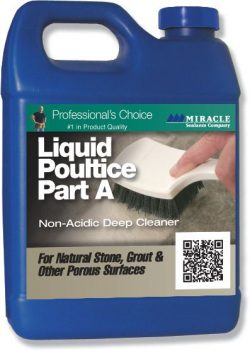GENERAL CLEANING
We recommend the use of ‘Miracle’ proprietary tile cleaners as these are specifically formulated for the task. General purpose detergents and other household cleaning products may leave residues that build up and trap dirt and may also contain harmful chemicals that could damage ceramic tiles and natural stone products.
Slip resistant finishes can be cleaned effectively by employing the correct tools and techniques.
Alstonville Tiles & Floorcoverings recommended method is:-
- Sweep or vacuum the floor of loose dirt.
- Apply the proprietary cleaning solution (Floor cleaner + water to recommended dilution) to the floor.
- Broom or brush the solution around the floor: for slip resistant tiles a brick mop (3M doodle bug) works best
- Generally only agitation rather than scrubbing will be required.
- Rinsing with clean water is essential – this can be done by sluicing, mopping or a wet vacuum.
- Remove water from the floor.
- Buff with a dry towel or mop.
- Alternatively for regular general cleaning a steam mop is both an effective and hygienic non chemical solution.
Most problems with floor cleaning relate to poor rinsing, which leads to a build-up of detergent residues. These residues in turn trap more dirt. This cycle is easy to break with an improved rinsing step. For severe build-up a deep clean with a stronger detergent and thorough rinse may be required to restore the floor.
CARE & MAINTENANCE TIPS
- For new homes under construction it is recommended that ceramic tiles not be installed until all heavy construction work has been completed.
- It is vital to protect the tiles to avoid damage and staining during the construction period as dust and debris will collect on the floor creating hazardous and slippery conditions. This dirt and debris may also soil the grout and the tiles. – It is therefore recommended that the tiles be covered for protection.
- Cementitious residues from the grouting process are often still present on the tile’s surface, although this may not be visible to the naked eye. This residue will trap dirt thus giving the impression that the tiles are hard to clean. The residue must be removed using a proprietary grout remover, such as the Phosphoric Acid Cleaner.
- Do not use abrasive cleaners or chemicals such as Hydrochloric Acid, which could permanently etch, scratch or damage the tile’s surface.
- Heavy duty acidic cleaners should NOT be used on acid sensitive natural stones such as polished marble, limestone or travertine.
- When the time comes to re-seal your natural stone, porcelain tile or grout, be sure that it is sufficiently clean; otherwise the contaminants will be sealed into the surface.
- The use of quality door mats at entry thresholds will remove most abrasive material that would otherwise be walked into the home and which could scratch and damage a tiled floor. This is particularly important if a high gloss or polished tile has been installed and especially so if the home is situated near the beach; as sand is one of the most damaging abrasives known.
STAIN REMOVAL
Stains should be treated as soon as possible. As time goes by it becomes increasingly difficult to remove the stain. The nature of the stain should always be determined prior to making any attempt at removal. Using the appropriate removal technique is important to achieve desired results. You must ask questions to determine what the stain is. What is the colour? Where is it located? How long has it been there? Is it associated with the main traffic areas? Are plants near the stain? Etc.
Test patches will need to be performed. In many cases it will take several tests. Once the stain has been identified then the appropriate measures can be taken for its removal.
NOTE: Some chemicals necessary for stain removal will remove the finish on polished marble, limestone, terrazzo and travertine. As a result, repolishing with abrasives or polishing compounds may become necessary.
TYPICAL STAINS:
ORGANIC: Coffee, tea, tobacco, food, cosmetics, plant materials, such as tannin etc
INORGANIC: Rust, iron, bronze, steel, metal.
BIOLOGICAL: Mildew, mould, fungus and algae.
OIL BASE: Grease, cooking oil, food stains, tar, and body oil
INK: Ball Point Pen or Magic Marker
STAIN REMOVAL GUIDE
| CHALLENGE | SOLUTION |
| IRON STAINS: | Clean with: |
| Miracle Sealants Liquid Poultice | |
| Miracle Sealants Heavy Duty Acidic Cleaner | |
| INK STAINS: | Poultice with: |
| Miracle Sealants Liquid Poultice | |
| Miracle Sealants Mira Strip | |
| OIL BASE STAINS: | Clean with: |
| Miracle Sealants Tile & Stone Cleaner | |
| Miracle Sealants Liquid Poultice | |
| Miracle Sealants Mira Strip | |
| Poultice with: | |
| Miracle Sealants Mira Strip | |
| ORGANIC STAINS: | Clean or Poultice with: |
| Miracle Sealants Tile & Stone Cleaner | |
| Miracle Sealants Liquid Poultice | |
| BIOLOGICAL STAINS: | Clean with: |
| Miracle Sealants Tile & Stone Cleaner | |
| Miracle Sealants Liquid Poultice | |
| CEMENTITIOUS RESIDUES: | Clean with: |
| Not Recommended on Polished Surfaces | Miracle Sealants Heavy Duty Acidic Cleaner |
| On Honed Surfaces: | Dilute to a ratio of 5 – 1 |
| On Flamed or Textured Surfaces: | Dilute to a ratio of 3 – 1 |
| EPOXY GROUT RESIDUE: | Miracle Sealants Epoxy Grout Film Remover – Use undiluted on all Surfaces |
*ALWAYS TEST A SMALL AREA TO ENSURE THE DESIRED RESULTS
Visit the Miracle Sealants Website below for further information:
http://miraclesealants.com.au/support-tools/stain-removal-guide/






